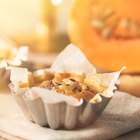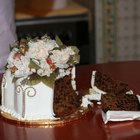A well-made quiche can be either an economical brunch filled with leftovers from your fridge, or an elegant, light lunch for company. Either way, it's best when it has time to rest after baking. Traditionally, quiche is served at room temperature or just slightly warmer. In the modern age, that raises questions of food safety, with warm eggs and cream providing a near-ideal environment for bacteria. For that reason, it's important to limit the time a quiche spends outside of refrigeration.
Time, Temperature and Microscopic Good Times
Almost every food contains at least a few bacteria, including some that might be harmful. They don't usually result in illness, because it takes a certain-sized population of microorganisms -- called the "infective dose" -- to make someone sick. Like humans, microorganisms reproduce most freely at comfortable temperatures. At temperatures below 40 degrees Fahrenheit they're sluggish, and reproduce slowly. At temperatures above 140 F, they're protecting themselves from the heat and trying to survive. That 100-degree spread is referred to as the food-safety "danger zone," because microorganisms reproduce rapidly within that range. That's why it's important to track, and sharply limit, non-refrigerator time.
The Time Limit
Food safety authorities such as the USDA's Food Safety and Inspection Service consider two hours to be the limit for food safety within that range of temperatures. With quiche, that two-hour time limit applies twice. Once you've made up the egg-and-cream filling, it should be baked off or refrigerated within two hours. Baking the quiche raises the filling to a food safe temperature, killing potentially dangerous microorganisms and re-starting the two hour clock. Within two hours of the the quiche cooling to 140 F, it should be wrapped and refrigerated.
Reheating the Quiche
Your leftover quiche can be eaten straight from the refrigerator, but it's not especially pleasant or flavorful when it's cold. Reheating it is best, either as a whole or in individual slices. Simply warming the quiche in your oven or microwave will restore its flavors, and oven-warming has the added benefit of re-crisping the crust. To ensure food safety, the USDA recommends that you reheat all leftovers to an internal temperature of 165 F. That kills any bacteria that might have re-established themselves in the quiche, minimizing the risk of illness. It might dry the quiche slightly, but a drizzle of sauce or warmed heavy cream can counteract that.
Storing Your Quiche
Once you've covered and refrigerated your quiche, you'll have a few days to use it up. The USDA's Food Safety and Inspection Service recommends using up any leftovers containing eggs within 3 to 4 days, to minimize any risk of illness. If you'd like to keep a few portions for a longer period, wrap them in plastic film wrap or in individual freezer bags and date them. Keep them in your freezer for one to four months, pulling out a portion and reheating it whenever you wish. After four months the quiche will still be safe, but its taste and texture will suffer.
Related Articles
Can I Make Quiche Ahead of Time?

Do Boston Cream Pie Cupcakes Need ...

How Long to Cool a Quiche
Baking Quiche the Day Before the Party

Nutrition Facts for Ham, Cheese & Egg ...

How to Heat Lasagna From the Fridge

Cooking Frozen Vs. Defrosted Food

How to Keep Baked Goods Moist Overnight

How Early Can You Make a Wedding Cake?

How to Make a Box Cake Firmer to Frost

FDA Food Storage Temperature Guidelines

How to Freeze Manicotti

Do I Cook Frozen Broccoli Before Baking ...

How to Fix Grainy Whipped Ganache

Can I Refreeze Cheesecake?

Freezing a Moussaka
How Long Before a Hard Boiled Egg Goes ...

How Long Can a Bagel With Cream Cheese ...

How Does Thermal Underwear Work?
How to Freeze a Baguette
References
Writer Bio
Fred Decker is a trained chef and prolific freelance writer. In previous careers, he sold insurance and mutual funds, and was a longtime retailer. He was educated at Memorial University of Newfoundland and the Northern Alberta Institute of Technology. His articles have appeared on numerous home and garden sites including GoneOutdoors, TheNest and eHow.